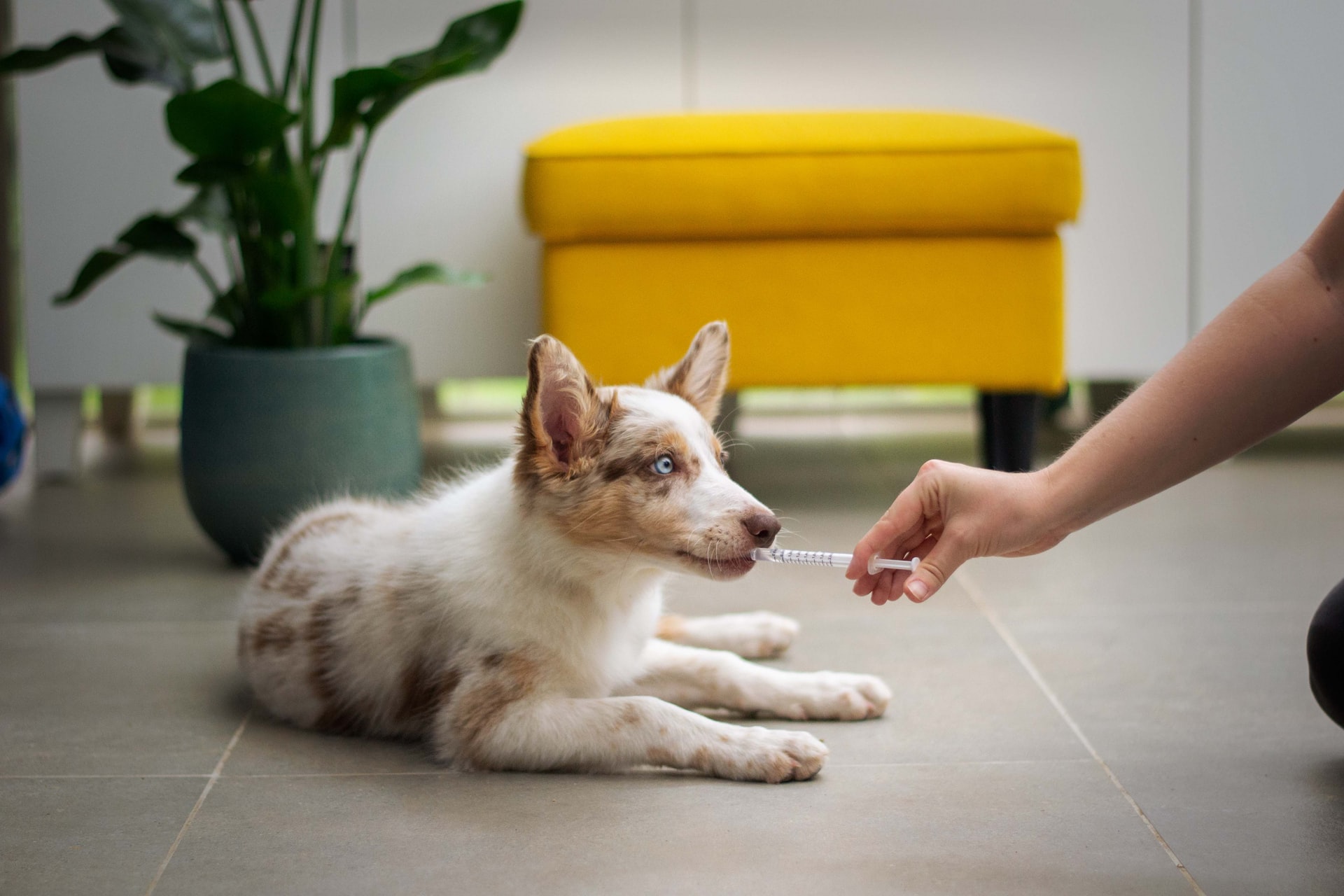The Ultimate Dog Vaccine Guide
Most British dog owners are familiar with the need for jabs and boosters, but here Laura Keyser explains more about the conditions we are vaccinating for.

Most British dog owners are familiar with the need for dog vaccines and boosters, but here, Laura Keyser explains more about the conditions we are vaccinating against and why.
Dog vaccines can help to prevent contagious and potentially fatal diseases. Vaccines work by stimulating an immune response, which lasts a varying amount of time depending on the vaccine and the disease it is trying to prevent.
Why Are Dog Vaccines So Important?
A vaccine contains a small dose of either dead or inactivated bacteria or virus, which means it’s unable to cause disease, but is sufficient to invoke an immune response, so the immune system develops specific antibodies against the disease.
There are four core vaccines, which are essential:
- Distemper vaccine
- Hepatitis vaccine
- Parvovirus (parvo) vaccine
- Leptospirosis vaccine
There’s also the kennel cough vaccine, which is highly recommended but not essential, as well as a rabies vaccine for dogs, which is required if you plan to take your dog outside the UK.
How Do Dog Vaccines Work?
When puppies are first born, they rely completely on antibodies transferred across the placenta and provided in their mother’s colostrum (first milk) to protect them against harmful bacteria and viruses. This is known as passive immunity, as it involves one animal producing antibodies and then transferring them to a susceptible animal to provide immediate protection. As a result, it’s vital to ensure that bitches are fully vaccinated if you’re breeding from them.
Over the first few months of their life, this protection wanes, making the puppy more vulnerable to infectious diseases. It’s therefore important to vaccinate puppies at the right age and then ongoing throughout their lives.
Most vaccinations are given as a single, combined subcutaneous injection (just under the skin), usually in the scruff of the neck where there is plenty of skin to hold. The only one that differs is the kennel cough vaccine, which is an intra-nasal vaccine in the UK, given up the dog’s nostril, although an oral vaccine has recently been launched.
The 4 Core Dog Vaccines
There are four essential dog vaccines that every dog needs to have as a puppy, as well as a number of recommended but ‘non-core’ vaccines. Here’s everything you need to know about the four core dog injections:
1. Distemper Vaccine
Distemper is also known as hard pad, and it’s a highly contagious, often fatal, viral disease. It can take many forms and affect several of the dog’s body systems, meaning it can often be quite difficult to diagnose. Signs of distemper in dogs can include:
- Fever
- Reduced white blood cells
- Nasal discharge
- Gastrointestinal signs (vomiting and diarrhoea)
- Inflammation of the lungs and brain
- Walking in circles
- Head tilt
- Uncontrolled rapid eye movements (nystagmus)
- Muscle twitching of localised muscle groups, such as the leg or face
- Partial or complete paralysis of the hind limbs due to muscle incoordination
- Overgrowth of skin on the footpads and nose (hence the nickname ‘hard pad’)
A dog can become infected with distemper by inhaling the virus from droplets spread by an affected dog. Usually a short spell of fever follows for about three to six days after infection. This may go unnoticed, or it may be accompanied by lethargy and a loss of appetite. If blood tests are taken at this point, they may show a low white blood cell count.
A second episode of fever may be accompanied by lethargy, loss of appetite, and nasal and ocular discharge. Gastrointestinal signs and respiratory symptoms (coughing or breathlessness) may follow and are complicated by secondary bacterial infections.
Seizures may develop as the condition progresses, with jaw chomping, involuntary urination and defecation. The seizures become more frequent and severe over time.
Distemper infections may be mild with few or no signs with a short time course, or may be severe with most of the symptoms described. Sometimes the onset of neurological signs can be delayed for several weeks.
Treatments for Distemper
Dogs need to be treated on an individual basis, depending on their symptoms, and may make a full recovery but a prompt diagnosis and aggressive treatment is essential. However, even with the right treatment, some dogs do not make a satisfactory recovery and euthanasia may have to be considered. Treatments for distemper include:
- Antibiotics
- Intravenous fluids
- Anti-inflammatories to reduce fever and control pain
- Anticonvulsants, if the dog is having seizures
2. Hepatitis Vaccine
Canine infectious hepatitis, caused by canine adenovirus, is a contagious disease spread by the ingestion of urine, faeces, or saliva from an affected dog. Even dogs that have recovered from hepatitis can continue to shed the virus in their urine for up to six months.
Signs Of Hepatitis In Dogs
Symptoms of hepatitis in dogs can include:
- Slight fever
- Lethargy
- Lack of appetite
- Unusual thirst
- Discharge from eyes and nose
- Enlarged tonsils
- Swelling of head, neck, and trunk
- Dark red mucous membranes (gums)
- Vomiting
- Depression
- Clotting disorders
- Abdominal pain
- Jaundice
- Severe hepatitis (inflammation of the liver).
Mortality rates range from 10 per cent to 30 per cent and are highest in very young dogs.
The first sign of hepatitis is usually a fever of over 40°C (104°F), which can last for up to six days. With hepatitis, a dog’s blood clotting times become prolonged, causing spontaneous bleeding, which can be difficult to control.
The nervous system is rarely involved but in severely affected dogs, this can lead to convulsions. In about 25% of recovered dogs, a cloudy corneal opacity (blue eye) develops in both eyes seven to 10 days after acute signs disappear and usually resolves itself spontaneously.
Treatment for hepatitis in dogs is symptomatic and supportive, involving antibiotics, intravenous fluids and blood transfusions in severely ill dogs.
3. Parvo Vaccine
Parvo (parvovirus) is a highly contagious virus that attacks the gastrointestinal system, causing severe vomiting, bloody diarrhoea, fever and loss of appetite. Extreme dehydration ensues and can be rapidly fatal (within 48-72 hours).
Parvovirus mainly affects young dogs, but generally unvaccinated (or incompletely vaccinated) dogs, and certain breeds, such as rottweilers, dobermans, German shepherds and English springer spaniels, are thought to be predisposed.
The parvo virus is resistant to many disinfectants, sunlight, and heat. It can persist for many months, possibly even years, in the outdoor environment. Higher incidences are found in dog rescue centres or breeding kennels.
Parvovirus is shed in the faeces of the infected dogs after 4-5 days of exposure and is spread by faecal-oral spread (the ingestion of faeces) or by contact with contaminated clothing, shoes, or equipment.
Parvovirus Symptoms
Symptoms generally develop within five to seven days of infection. Initially, signs may be non-specific, including lethargy, loss of appetite and fever, with progression to vomiting and haemorrhagic (bloody) diarrhoea within 24-48 hours.
Severely affected dogs can progress quickly to being in a collapsed state, with weak pulses, high heart rates and hypothermia (cold body temperature), consistent with septic shock.
How Is Parvovirus Diagnosed And Treated?
A faecal sample and blood tests help to confirm a parvovirus diagnosis and treatment must be instigated promptly otherwise it can sadly often be fatal. However, puppies that survive the first three or four days of illness are more likely to make a full recovery.
Parvovirus treatment can involve:
- Intravenous fluids to correct dehydration and electrolyte imbalances
- Plasma transfusions
- Anti-sickness drugs
- Antibiotics
- Antivirals
- Good nutrition, sometimes requiring a feeding tube to be placed and syringe feeding provided
4. Leptospirosis Vaccine
Leptospirosis or lepto is a bacterial disease that’s transmitted via rodent urine, which can be transmitted to humans, as well as other animal species. There are several strains of leptospirosis present in different species in different countries of the world. The most common in the UK are L. canicola and L. icterohaemorrhagiae.
What Are The Symptoms Of Leptospirosis?
Symptoms of leptospirosis in dogs can include:
- Fever
- Vomiting
- Abdominal pain
- Diarrhoea
- Loss of appetite
- Weakness
- Lethargy
- Stiffness
- Muscle pain
- Kidney failure (with or without liver failure).
Signs of kidney injury can either be urinating excessively or, conversely, producing less or even no urine. Acute liver disease may also occur, causing affected dogs to be jaundiced.
Less commonly, bleeding disorders can cause small bleeds on the gums and skin (petechiae), a bloody nasal discharge and blood in stools and vomit.
Leptospirosis is diagnosed via a blood test, which can confirm the presence of the bacteria. Supportive treatment includes intravenous fluids, antibiotics such as doxycycline, anti-sickness drugs, gut protectants, phosphate binders and drugs to support the liver.
How Safe Is The Leptospirosis Vaccine?
There has been a lot of press about the safety of the leptospirosis vaccine in the last few years, namely one known as L4.
Previously, most drug companies produced the L2 vaccine against the two common strains, L. canicola and L. icterohaemorrhagiae, but more recently strains have been discovered in populations of wild animals. As a result, an L4 vaccine was manufactured, containing four strains rather than two.
L4 has potentially been associated with more adverse reactions, simply because more antigen means the immune system is stimulated more, meaning there’s a greater risk of side effects. The overall risk of an adverse reaction with either L2 or L4 is still ‘rare’ meaning that less than 10 out of every 10,000 doses of this dog vaccine will trigger a reaction, ranging from mild to severe.
However, with L2, this risk is less than two in every 10,000, and with L4 the risk is less than seven in every 10,000 dogs.
In summary, the risk of an unvaccinated dog getting Leptospirosis far outweighs the risk of an adverse reaction with a vaccine, and the consequences could be far worse. Unless you travel abroad with your dog, or they are likely to swim in natural watercourses on farmland, then the L2 vaccine should be sufficient.
Non-Core Dog Vaccines
There are also some dog vaccines that are recommended, but not essential. You may need to speak to your vet about additional dog injections if you’re travelling abroad, for example, or you may want to find out more about the kennel cough vaccine.
1. Kennel Cough Vaccine
Infectious Tracheobronchitis (ITB) or kennel cough, is predominantly caused by the bacterium Bordetella Bronchiseptica, which may be combined with parainfluenza. Kennel cough is a sudden, or sometimes chronic, inflammation of the trachea and smaller (bronchial) airways, causing their walls to become inflamed and swollen, in turn, narrowing the airways.
Spasms of coughing are the most prominent sign of kennel cough. The cough attempts to remove accumulations of mucus from the airways. Often, it is most severe after rest, when the dog is excited, or during exercise. Dogs with kennel cough may have a slight temperature, but the acute stage of bronchitis passes in two to three days. However, the cough itself may persist for several weeks.
Generally, a kennel cough diagnosis is made based on the history, symptoms and physical examination of the dog. In severe or prolonged cases, X-rays, endoscopy, and fluid samples taken from the lungs may be recommended by your vet.
Infections often self-resolve or may require anti-inflammatories and cough suppressants to help ease the symptoms. Antibiotics are sometimes required if a bacteria component is confirmed. On rare occasions, severe cases of kennel cough can lead to pneumonia, which is why many owners view the vaccine as a priority. The annual kennel cough vaccine offered in the UK is currently available in intra-nasal or intra-oral form.
2. Parainfluenza Vaccine
Canine parainfluenza is a virus that contributes towards kennel cough. Parainfluenza is highly contagious and spreads easily when dogs are in close proximity to each other for a period of time, such as in boarding kennels or within groups of working dogs and hunt kennels. When combined with Bordetella Bronchiseptica, parainfluenza can result in the classic signs of kennel cough.
Symptoms of parainfluenza can include:
- A dry, hacking cough
- Fever, sometimes
- Nasal discharge
- Sneezing
- Inflamed eyes
- Depression
- Lethargy
- Loss of appetite
Treatment for parainfluenza is usually just supportive, involving anti-inflammatories to ease the fever and cough. Antibiotics are not generally required.
The parainfluenza vaccine is available in injectable or intra-nasal forms.
3. Rabies Vaccine For Dogs
Rabies is a fatal disease for both dogs and humans, characterised by a swaying gait, painful neck, excessive salivation, and convulsions of facial muscles. Aggressive behaviour can be seen in dogs with rabies, even with biting and not letting go.
If you’re planning to travel outside of the UK with your dog, it will need a rabies vaccination before travel. UK licensed rabies vaccines for dogs last for three years, but in Europe, some are only licensed for one year. Contact your vet to discuss the protocol for travel at least four months before your proposed travel date.
When Should Dog Vaccines Be Given?
Depending on the brand, dog vaccines usually involve a combined annual injection, containing all the core vaccines, given in one subcutaneous injection. The rabies and kennel cough vaccine are also available and are given separately.
The primary vaccinations for puppies involve two injections, generally given 2-4 weeks apart. Sometimes, a breeder may decide to give the first vaccination prior to selling puppies and this can be given from six weeks of age. The second vaccine must be given after the age of 10 weeks to ensure that all maternity antibodies have waned and the puppy develops its own immunity.
After the primary course of dog vaccines, the next injection is given 12 months later and should be given annually thereafter. If your dog has gone three months overdue with their booster vaccination (i.e. it’s over 15 months since their last vaccination), it’s recommended to restart the vaccination course, so two primary vaccines will be given again, 2-4 weeks apart.
Remember that it’s vital that potential breeding bitches are fully vaccinated to ensure that antibodies are passed on to the puppies via the uterus and through their colostrum.
The alternative to vaccinations is titre testing. A blood sample can be taken to check antibody levels in the blood. The test helps reduce vaccination failure and some people believe it prevents over-vaccination and helps owners to make informed dog vaccine-related decisions. If an animal already has a protective level of immunity, revaccination will not be required. If titre levels are inadequate, then revaccination is recommended. The downfall of titre tests is that only hepatitis, parvovirus, and distemper can be tested for.
If you have any questions about dog injections and which ones are necessary for your gundog, please contact us here.
Related Articles
Get the latest news delivered direct to your door
Subscribe to Gundog Journal
Unlock the full potential of your working dog with a subscription to Gundog Journal, the UK’s only dedicated magazine for gundog enthusiasts. Published bi-monthly, this authoritative resource delivers expert training advice, in-depth interviews with top trainers and veterinary guidance to help you nurture a stronger bond with your dog.
With stunning photography and thought-provoking content, Gundog Journal is your essential guide to understanding, training and celebrating your working dog.
Save 10% on shop price when you subscribe, with a choice of packages that work for you. Choose from Print & Digital or Digital only with each journal delivered directly to your door or via the app every other month, plus access to past issues with the digital back issue library.













